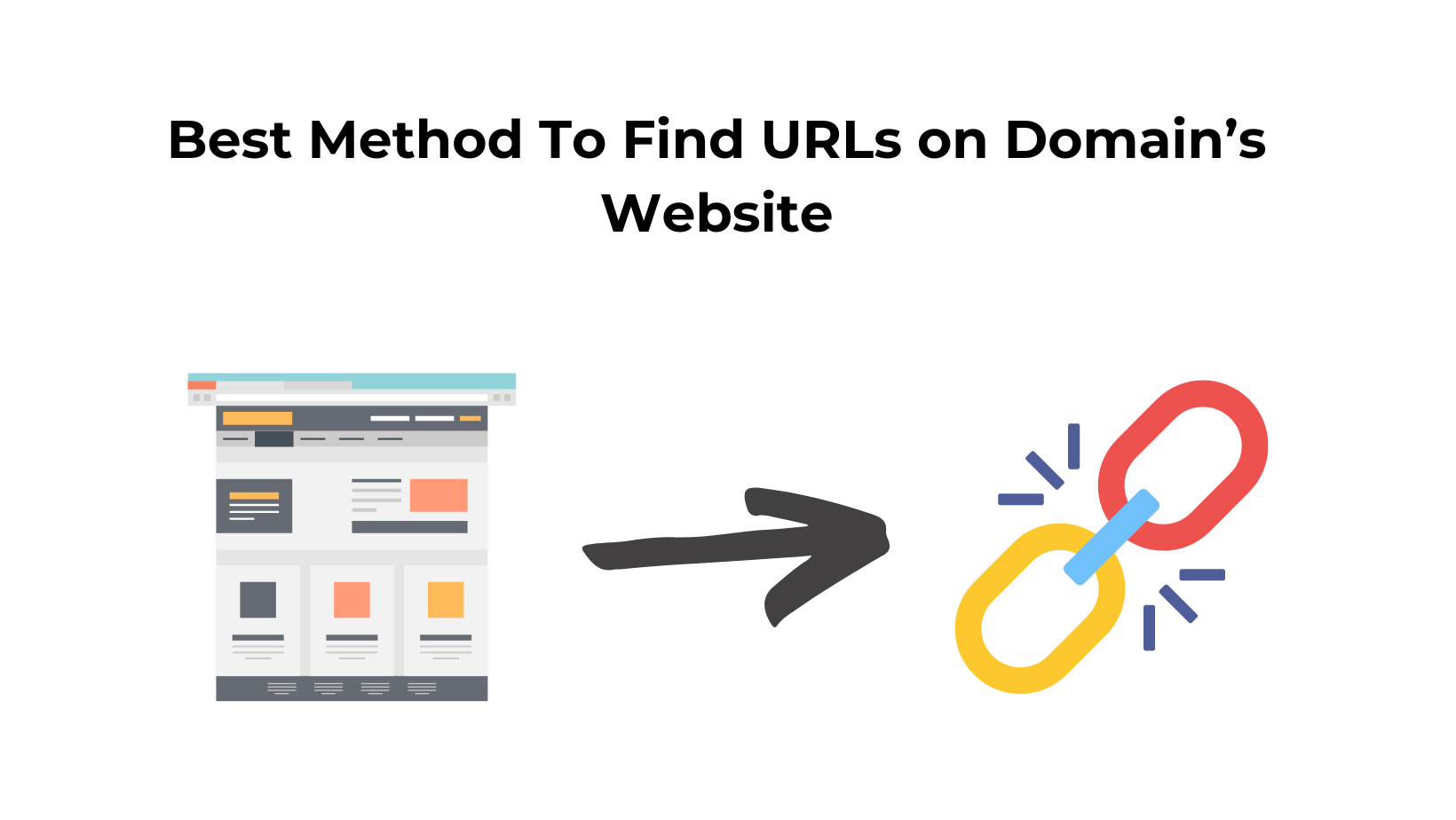Find All URLs on a Domain: A Complete Guide to Extracting Web Addresses Efficiently

In the vast world of the internet, Find all urls on a domain millions of websites are active, each with its own unique set of pages, articles, images, and resources. For webmasters, SEO specialists, and digital marketers, understanding how to find all URLs on a domain is crucial. Whether you’re working to improve search engine optimization (SEO), conducting site audits, or simply gathering information about a website’s structure, discovering the URLs within a domain can save you time and effort. In this comprehensive guide, we’ll dive deep into different methods and tools you can use to effectively find all URLs on a domain.
What Does “Find All URLs on a Domain” Mean?

Before diving into the “how,” it’s essential to understand the “what.” When we say find all URLs on a domain, we’re referring to the process of discovering every webpage, resource, or link associated with a particular website or domain. These URLs might include blog posts, product pages, images, internal links, and even hidden files that are accessible through the site.
In simple terms, it’s like mapping out every street in a town—only here, the “streets” are web pages, and the “town” is the entire website. The process of finding all URLs on a domain can help you understand the structure of the site, track internal link health, and even improve your site’s performance on search engines.
Why Do You Need to Find All URLs on a Domain?
Finding all URLs on a domain isn’t just about curiosity—it serves several practical purposes. Here are a few reasons why you might need to find all URLs on a domain:
- SEO Audits: To identify broken links, orphan pages, or redirects that could harm your SEO performance.
- Competitive Analysis: To analyze the structure and content of a competitor’s website.
- Content Planning: To ensure you have a complete list of all your website’s pages when planning new content or updating old material.
- Crawl and Indexing: To ensure that search engines like Google have indexed all important pages on your site.
Having a complete list of URLs gives you a bird’s-eye view of a site’s structure, making it easier to improve your overall web strategy.
Methods to Find All URLs on a Domain
There are various methods to find all URLs on a domain, ranging from simple manual techniques to automated tools and software. Below, we’ll discuss both approaches, giving you options depending on your skill level and the size of the website you’re analyzing.
- Using Google Search to Find All URLs on a Domain
Google is one of the most powerful tools at your disposal when trying to find all URLs on a domain. By using Google’s search operators, you can narrow down the results to only show pages from a specific domain.
Here’s how you can do it:
- Go to Google’s search bar.
- Type in the following query: site:yourdomain.com
- Hit Enter.
This search will list indexed pages for your domain. For example, if you type site:example.com, you’ll see all indexed pages for the “example.com” website. While this won’t give you every URL (such as those that aren’t indexed), it’s a quick and easy way to gather a large portion of the URLs on the site.
- Use Screaming Frog SEO Spider
For a more thorough approach, Screaming Frog SEO Spider is one of the most popular tools used by SEO professionals. It crawls your website just like a search engine and lists all URLs on your domain. It’s available as both a free and paid version, with the free version limiting you to crawling up to 500 pages.
How to Use Screaming Frog:
- Download and install the Screaming Frog SEO Spider tool.
- Open the software and enter the URL of the website you want to analyze.
- Click “Start” to begin the crawl.
- Once the crawl is complete, the tool will show you a detailed list of all the URLs on the website.
Screaming Frog provides valuable information such as page titles, meta descriptions, status codes, and even internal linking structures, making it an essential tool for site audits.
- Using Xenu’s Link Sleuth
Xenu’s Link Sleuth is another reliable tool that can help you find all URLs on a domain. It’s particularly known for crawling websites and identifying broken links, but it also provides a comprehensive list of all URLs. It’s a free tool with a simple interface, making it easy for beginners.
Steps to Use Xenu:
- Download and install Xenu’s Link Sleuth.
- Open the program and enter the domain or URL you want to analyze.
- Click on “Check” to start crawling the site.
- Once the crawl finishes, Xenu will generate a list of all the URLs, including their status codes (e.g., 404 for broken links).
Xenu provides a basic yet effective way to find URLs, making it a good choice for smaller websites.
- Using Site Map Files
Many websites provide a sitemap file that lists all URLs on the domain. This file, usually located at yourdomain.com/sitemap.xml, can be easily accessed and parsed for URLs. A sitemap is particularly useful because it’s designed specifically for search engines to crawl and index the site’s pages.
To find the sitemap:
- Look for the robots.txt file on the website. This file often contains a link to the sitemap.
- Alternatively, you can try accessing the sitemap directly by typing yourdomain.com/sitemap.xml in the browser.
If the site has a sitemap, it will provide a comprehensive list of URLs that you can manually collect or use as a tool to extract the links.
- Use Online Tools to Find All URLs
There are several online tools available that can crawl websites and provide a list of all URLs on a domain. These tools can be handy for quick tasks or if you’re working on smaller websites. Some of the most popular tools include:
- Sitebulb: A paid tool that offers detailed site audits, including URL discovery.
- Siteliner: A free tool that checks your site for duplicate content and lists all URLs.
- Ahrefs: Although primarily an SEO tool, Ahrefs offers a “Site Explorer” that can show all pages indexed by Google.
These tools often provide additional SEO-related insights, making them useful for webmasters and marketers.
- Command Line Tools for Developers
For those with a bit of technical expertise, command-line tools like Wget or Curl can be used to crawl a website and find URLs. These methods might require some coding knowledge, but they offer more control and flexibility when gathering data from a website.
For example, using wget:
- Open the terminal on your computer.
- Type the following command: wget –spider –recursive –level=inf –no-verbose yourdomain.com
- This command will start the crawl and list all the URLs in the terminal.
- Using Python Scripts for URL Extraction
If you’re comfortable with coding, Python provides powerful libraries, such as BeautifulSoup and requests, to write custom scripts for crawling websites. These scripts can be tailored to find specific types of URLs, including those that might not be linked publicly.
Example Python Script to Find URLs:
Python
Copy code
import requests
from bs4 import BeautifulSoup
def find_urls(domain):
response = requests.get(domain)
soup = BeautifulSoup(response.text, ‘html.parser’)
for link in soup.find_all(‘a’):
print(link.get(‘href’))
find_urls(‘http://example.com’)
This simple script will gather all the URLs from the homepage of a given domain. By modifying it, you can make it crawl additional pages, scrape more information, or handle errors gracefully.
- The Importance of Regularly Finding All URLs
Regularly finding all URLs on your domain is a best practice for maintaining the health of your website. Here’s why:
- Broken Link Detection: By discovering all the URLs, you can easily identify and fix broken links, preventing potential SEO penalties.
- Page Monitoring: Ensure all important pages are accessible and indexed by search engines.
- User Experience: A well-organized site structure with no broken links improves user experience.
- Common Pitfalls When Finding All URLs on a Domain
While the process of finding URLs is fairly straightforward, there are some common issues to be aware of:
- Incomplete Crawls: Sometimes, crawlers miss certain pages, especially those hidden behind forms or JavaScript. Make sure to use different tools to cross-check.
- Duplicate URLs: Websites often have duplicate content, which can be confusing. Be sure to focus on unique URLs and ignore redundant ones.
- Access Restrictions: Some websites restrict crawling using the robots.txt file or through CAPTCHAs. Always respect the website’s rules when using crawlers.
Conclusion: Mastering the Process to Find All URLs on a Domain
Now that you have a thorough understanding of how to find all URLs on a domain, you’re equipped with the knowledge to explore any website’s structure, conduct audits, and improve your SEO performance. Whether you’re using Google Search, Screaming Frog, Xenu, or Python scripts, each method offers its own set of benefits depending on your needs.
By regularly finding and monitoring the URLs on your domain, you ensure that your website remains optimized, user-friendly, and search engine-friendly. With the right tools and knowledge, you can unlock the full potential of your website, helping you stay ahead in the competitive online landscape.
Remember, finding all URLs on a domain is not just about gathering data—it’s about taking actionable insights and using them to enhance the overall health and performance of your website. Happy crawling!





